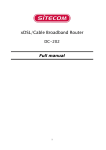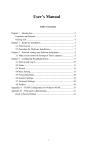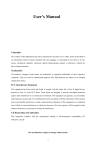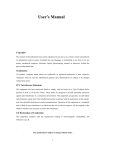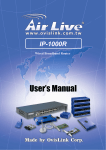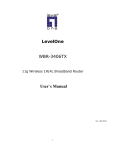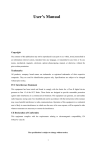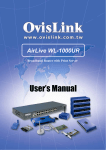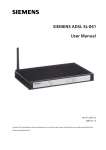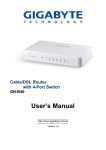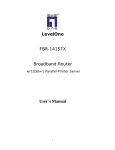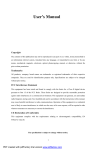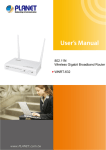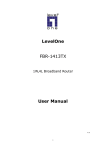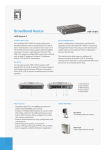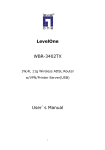Download LevelOne - Mayflex
Transcript
LevelOne FBR-1418TX 1W,4L Broadband Router User Manual V1.1 i Copyright The contents of this publication may not be reproduced in any part or as a whole, stored, transcribed in an information retrieval system, translated into any language, or transmitted in any form or by any means, mechanical, magnetic, electronic, optical, photocopying, manual, or otherwise, without the prior written permission. Trademarks All products, company, brand names are trademarks or registered trademarks of their respective companies. They are used for identification purpose only. Specifications are subject to be changed without prior notice. FCC Interference Statement This equipment has been tested and found to comply with the limits for a Class B digital device pursuant to Part 15 of the FCC Rules. These limits are designed to provide reasonable protection against radio interference in a commercial environment. This equipment can generate, use and radiate radio frequency energy and, if not installed and used in accordance with the instructions in this manual, may cause harmful interference to radio communications. Operation of this equipment in a residential area is likely to cause interference, in which case the user, at his own expense, will be required to take whatever measures are necessary to correct the interference. CE Declaration of Conformity This equipment complies with the requirements relating to electromagnetic compatibility, EN 55022/A1 Class B . The specification is subject to change without notice. ii Table of Contents CHAPTER 1 INTRODUCTION ............................................................................. 2 FUNCTIONS AND FEATURES ...................................................................................... 2 PACKING LIST ............................................................................................................ 4 CHAPTER 2 HARDWARE INSTALLATION....................................................... 5 2.1 PANEL LAYOUT .................................................................................................... 5 2.2 RESET TO FACTORY DEFAULT ............................................................................. 6 2.3 PROCEDURE FOR HARDWARE INSTALLATION ..................................................... 7 CHAPTER 3 NETWORK SETTINGS AND SOFTWARE INSTALLATION ... 8 3.1 MAKE CORRECT NETWORK SETTINGS OF YOUR COMPUTER ........................... 8 CHAPTER 4 CONFIGURING BROADBAND ROUTER .................................. 9 4.1 START-UP AND LOG IN....................................................................................... 10 4.2 STATUS.............................................................................................................. 11 4.3 W IZARD ............................................................................................................. 12 4.4 BASIC SETTING ................................................................................................. 14 4.4.1 Primary Setup – WAN Type, Virtual Computers ................................ 15 4.5.1 Virtual Server .......................................................................................... 22 4.5.2 Special AP ............................................................................................... 23 4.6 SECURITY SETTINGS ........................................................................................ 26 4.6.1 Packet Filter ............................................................................................ 27 4.6.2 Domain Filter ........................................................................................... 32 4.6.3 URL Blocking .......................................................................................... 34 4.6.5 Miscellaneous Items .............................................................................. 38 4.7 ADVANCED SETTINGS ....................................................................................... 40 4.7.2 System Log.............................................................................................. 42 4.7.3 Dynamic DNS.......................................................................................... 43 4.7.4 SNMP Setting .......................................................................................... 45 4.7.5 Routing Table .......................................................................................... 46 4.7.6 Schedule Rule......................................................................................... 48 4.8 TOOLBOX........................................................................................................... 52 APPENDIX A TCP/IP CONFIGURATION FOR WINDOWS 95/98 ............... 57 1 C Chhaapptteerr 11 IInnttrroodduuccttiioonn Congratulations on your purchase of this outstanding LevelOne FBR-1418TX Broadband Router. This product is specifically designed for Small Office and Home Office needs. It provides a complete SOHO solution for Internet surfing, and is easy to configure and operate even for non-technical users. Instructions for installing and configuring this product can be found in this manual. Before you install and use this product, please read this manual carefully for fully exploiting the functions of this product. Functions and Features Router Basic functions Broadband modem and NAT Router Connects multiple computers to a broadband (cable or DSL) modem or an Ethernet router to surf the Internet. Auto-sensing Ethernet Switch Equipped with a 4-port auto-sensing Ethernet switch. WAN type supported The router supports some wan types, Static ,Dynamic, PPPOE ,PPTP , Dynamic IP with Road Runner. Firewall All unwanted packets from outside intruders are blocked to protect your Intranet. DHCP server supported All of the networked computers can retrieve TCP/IP settings automatically from this product. Web-based configuring Configurable through any networked computer’s web browser using Netscape or Internet Explorer. Multi-language support in Web-based configuring Supports English, Deutsh, Korean, and Chinese Web-based user interface. Virtual Server supported Enables you to expose WWW, FTP and other services on your LAN to be accessible to Internet users. User-Definable Application Sensing Tunnel User can define the attributes to support the special applications requiring multiple connections, like Internet gaming, video conferencing, Internet telephony and so on, then this product can sense the application type and open multi-port tunnel for it. DMZ Host supported Lets a networked computer be fully exposed to the Internet; this function is used when special application sensing tunnel feature is insufficient to allow an application to function correctly. 2 Statistics of WAN Supported Enables you to monitor inbound and outbound packets Security functions Packet filter supported Packet Filter allows you to control access to a network by analyzing the incoming and outgoing packets and letting them pass or halting them based on the IP address of the source and destination. Domain Filter Supported Let you prevent users under this device from accessing specific URLs. URL Blocking Supported URL Blocking can block hundreds of websites connection by simply a keyword. VPN Pass-through The router also supports VPN packet pass-through. SPI Mode Supported When SPI Mode is enabled, the router will check every incoming packet to detect if this packet is valid. DoS Attack Detection Supported When this feature is enabled, the router will detect and log the DoS attack comes from The Internet. Advanced functions System time Supported Allow you to synchronize system time with network time server. E-mail Alert Supported The router can send its info by mail. Dynamic dns Supported At present,the router has 3 ddns.dyndns,TZO.com and dhs.org. SNMP Supported The router supports basic SNMP function. Routing Table Supported Now, the router supports static routing. Schedule Rule supported Customers can control some functions, like virtual server and packet filters and determine when to access or when to block. 3 Other functions UPNP (Universal Plug and Play)Supported The router also supports this function. The applications: X-box, Msn Messenger. Packing List FBR-1418TX Power Adapter CAT-5 Cable CD Manual Quick Installation Guide 4 C Chhaapptteerr 22 H Haarrddw waarree IInnssttaallllaattiioonn 2.1 Panel Layout 2.1.1. Front Panel LED: LED POWER Function Power indication Color Status Green On Orange Blinking System Status status indicators On WAN Link/Act. 1~4 WAN port activity Green Blinking Link status Green On Blinking 10/100 Data Rate Green On Description Power is being applied to this product. Status LED is flashed once per second to indicate system is alive. The WAN port is linked. The WAN port is sending or receiving data. An active station is connected to the corresponding LAN port. The corresponding LAN port is sending or receiving data. Data is transmitting in 100Mbps on the corresponding LAN port. 5 2.1.2. Rear Panel Ports: Port Description 9VAC Power inlet: AC9V, 1A WAN the port where you will connect your cable (or DSL) modem or Ethernet router. Port 1-4 the ports where you will connect networked computers and other devices. RESET Reset button allows you to reset the FBR-1418TX. 2.2 Reset to factory Default There are 2 methods to reset to default. 1. Restore with RESET button First, turn off the router and press the RESET button in. And then, power on the router and hold the RESET button down until the Status LED start flashing, then move away the hand. If LED flashes about 8 times, the RESTORE process is completed. However, if LED flashes 2 times, repeat. 3. Restore directly when the router power on First, hold the RESET button about 5 seconds (STATUS will start flashing about 5 times). Move away the hand. The RESTORE process is completed. 6 2.3 Procedure for Hardware Installation 1. Decide where to place your Broadband Router You can place your FBR-1418TX Broadband Router on a desk or other flat surface, or you can mount it on a wall. For optimal performance, place your Broadband Router in the center of your office (or your home) in a location that is away from any potential source of interference, such as a metal wall or microwave oven. This location must be close to power and network connection. 2. Setup LAN connection a. Wired LAN connection: connects an Ethernet cable from your computer’s Ethernet port to one of the LAN ports of this product. Figure 2-3 Setup of LAN and WAN connections for this product. 3. Setup WAN connection Prepare an Ethernet cable for connecting this product to your cable/xDSL modem or Ethernet backbone. Figure 2-3 illustrates the WAN connection. 4. Power on Connecting the power cord to power inlet and turning the power switch on, this product will automatically enter the self-test phase. When it is in the self-test phase, the STATUS indicators will be lighted ON for about 10 seconds, and then will be flashed 3 times to indicate that the self-test operation has finished. Finally, the STATUS Led will be continuously flashed once per second to indicate that this product is in normal operation. 7 C Chhaapptteerr 33 N Neettw woorrkk S Seettttiinnggss aanndd S Sooffttw waarree IInnssttaallllaattiioonn To use LevelOne FBR-1418TX correctly, you have to properly configure the network settings of your computers and install the attached setup program into your MS Windows platform (Windows 98SE/ME/2000/XP). 3.1 Make Correct Network Settings of Your Computer The default IP address of this product is 192.168.123.254, and the default subnet mask is 255.255.255.0. These addresses can be changed on your need, but the default values are used in this manual. If the TCP/IP environment of your computer has not yet been configured, you can refer to Appendix A to configure it. For example, 1. configure IP as 192.168.123.1, subnet mask as 255.255.255.0 and gateway as 192.168.123.254, or more easier, 2. configure your computers to load TCP/IP setting automatically, that is, via DHCP server of this product. After installing the TCP/IP communication protocol, you can use the ping command to check if your computer has successfully connected to this product. The following example shows the ping procedure for Windows 95 platforms. First, execute the ping command ping 192.168.123.254 If the following messages appear: Pinging 192.168.123.254 with 32 bytes of data: Reply from 192.168.123.254: bytes=32 time=2ms TTL=64 a communication link between your computer and this product has been successfully established. Otherwise, if you get the following messages, Pinging 192.168.123.254 with 32 bytes of data: Request timed out. There must be something wrong in your installation procedure. You have to check the following items in sequence: 1. Is the Ethernet cable correctly connected between this product and your computer? Tip: The LAN LED of this product and the link LED of network card on your computer must be lighted. 2. Is the TCP/IP environment of your computers properly configured? Tip: If the IP address of this product is 192.168.123.254, the IP address of your computer must be 192.168.123.X and default gateway must be 192.168.123.254. 8 C Chhaapptteerr 44 C Coonnffiigguurriinngg B Brrooaaddbbaanndd R Roouutteerr LevelOne FBR-1418TX provides Web based configuration scheme, that is, configuring by your Web browser, such as Netscape Communicator or Internet Explorer. This approach can be adopted in any MS Windows, Macintosh or UNIX based platforms. 9 4.1 Start-up and Log in Activate your browser, and disable the proxy or add the IP address of this product into the exceptions. Then, type this product’s IP address in the Location (for Netscape) or Address (for IE) field and press ENTER. For example: http://192.168.123.254. After the connection is established, you will see the web user interface of this product. There are two appearances of web user interface: for general users and for system administrator. To log in as an administrator, enter the system password (the factory setting is ”admin”) in the System Password field and click on the Log in button. If the password is correct, the web appearance will be changed into administrator configure mode. As listed in its main menu, there are several options for system administration. 10 4.2 Status This option provides the function for observing this product’s working status: A. WAN Port Status. If the WAN port is assigned a dynamic IP, there may appear a “Renew” or “Release” button on the Sidenote column. You can click this button to renew or release IP manually. B. Statistics of WAN: enables you to monitor inbound and outbound packets NOTE: After successful login, you can switch the language in the Web-based user interface. There are four languages available, which are English, German, Chinese, and Korean. Please select the language by clicking the option on the top-right corner. 11 4.3 Wizard Setup Wizard will guide you through a basic configuration procedure step by step. Press ”Next >” 12 Setup Wizard - Select WAN Type: For detail settings, please refer to 4.4.1 primary setup. 13 4.4 Basic Setting 14 4.4.1 Primary Setup – WAN Type, Virtual Computers Press “Change” 15 This option is primary to enable this product to work properly. The setting items and the web appearance depend on the WAN type. Choose correct WAN type before you start. 1. LAN IP Address: the local IP address of this device. The computers on your network must use the LAN IP address of your product as their Default Gateway. You can change it if necessary. 2. WAN Type: WAN connection type of your ISP. You can click Change button to choose a correct one from the following four options: A. Static IP Address: ISP assigns you a static IP address. B. Dynamic IP Address: Obtain an IP address from ISP automatically. C. Dynamic IP Address with Road Runner Session Management.(e.g. Telstra BigPond) D. PPP over Ethernet: Some ISPs require the use of PPPoE to connect to their services. E. PPTP: Some ISPs require the use of PPTP to connect to their services. F. L2TP: Some ISPs require the use of L2TP to connect to their services. 4.4.1.1 Static IP Address WAN IP Address, Subnet Mask, Gateway, Primary and Secondary DNS: enter the proper setting provided by your ISP. 4.4.1.2 Dynamic IP Address 1. Host Name: optional. Required by some ISPs, for example, @Home. 2. Renew IP Forever: this feature enables this product to renew your IP address automatically when the lease time is expiring-- even when the system is idle. 4.4.1.3 Dynamic IP Address with Road Runner Session Management.(e.g. Telstra BigPond) 1. LAN IP Address is the IP address of this product. It must be the default gateway of your computers. 2. WAN Type is Dynamic IP Address. If the WAN type is not correct, change it! 3. Host Name: optional. Required by some ISPs, e.g. @Home. 4. Renew IP Forever: this feature enable this product renew IP address automatically when the lease time is being expired even the system is in idle state. 16 Virtual Computers Virtual Computer enables you to use the original NAT feature, and allows you to setup the one-to-one mapping of multiple global IP address and local IP address. Global IP: Enter the global IP address assigned by your ISP. Local IP: Enter the local IP address of your LAN PC corresponding to the global IP address. Enable: Check this item to enable the Virtual Computer feature. This feature is only available in WAN type of Static IP Address, Dynamic IP Address and Dynamic IP Address with Road Runner Session. 4.4.1.4 PPP over Ethernet 1. PPPoE Account and Password: the account and password your ISP assigned to you. For security, this field appears blank. If you don't want to change the password, leave it empty. 2. PPPoE Service Name: optional. Input the service name if your ISP requires it. Otherwise, leave it blank. 3. Maximum Idle Time: the amount of time of inactivity before disconnecting your PPPoE session. Set it to zero or enable Auto-reconnect to disable this feature. 17 4. Maximum Transmission Unit (MTU): Most ISP offers MTU value to users. The most common MTU value is 1492. 4.4.1.5 PPTP 1. My IP Address and My Subnet Mask: the private IP address and subnet mask your ISP assigned to you. 2. Server IP Address: the IP address of the PPTP server. 3. PPTP Account and Password: the account and password your ISP assigned to you. If you don't want to change the password, keep it empty. 3. Connection ID: optional. Input the connection ID if your ISP requires it. 4. Maximum Idle Time: the time of no activity to disconnect your PPTP session. Set it to zero or enable Auto-reconnect to disable this feature. If Auto-reconnect is enabled, this product will automatically connect to ISP after system is restarted or connection is dropped. 4.4.1.6 L2TP 1. IP Mode: The IP Mode assigned by your ISP. You can select either Static IP Address or Dynamic IP address. 2. My IP Address and My Subnet Mask: the private IP address and subnet mask your ISP assigned to you when your IP Mode is Static IP Address. 3. Server IP Address: the IP address of the L2TP server. 4. L2TP Account and Password: the account and password your ISP assigned to you. If you don't want to change the password, keep it empty. 18 Maximum Idle Time: the time of no activity to disconnect your L2TP session. Set it to zero or enable Auto-reconnect to disable this feature. If Auto-reconnect is enabled, this product will automatically connect to ISP after system is restarted or connection is dropped. 19 4.4.2 DHCP Server Press “More>>” The settings of a TCP/IP environment include host IP, Subnet Mask, Gateway, and DNS configurations. It is not easy to manually configure all the computers and devices in your network. Fortunately, DHCP Server provides a rather simple approach to handle all these settings. This product supports the function of DHCP server. If you enable this product’s DHCP server and configure your computers as “automatic IP allocation” mode, then when your computer is powered on, it will automatically load the proper TCP/IP settings from this product. The settings of DHCP server include the following items: 1. DHCP Server: Choose “Disable” or “Enable.” 2. Lease Time: this feature allows you to configure IP’s lease time (DHCP client). 3. IP pool starting Address/ IP pool starting Address: Whenever there is a request, the DHCP server will automatically allocate an unused IP address from the IP address pool to the requesting computer. You must specify the starting and ending address of the IP address pool. 4. Domain Name: Optional, this information will be passed to the client. 5. Primary DNS/Secondary DNS: This feature allows you to assign DNS Servers 6. Primary WINS/Secondary WINS: This feature allows you to assign WINS Servers 7. Gateway: The Gateway Address would be the IP address of an alternate Gateway. 20 This function enables you to assign another gateway to your PC, when DHCP server offers an IP to your PC. 4.4.4 Change Password You can change Password here. We strongly recommend you to change the system password for security reason. 21 4.5 Forwarding Rules 4.5.1 Virtual Server 22 This product’s NAT firewall filters out unrecognized packets to protect your Intranet, so all hosts behind this product are invisible to the outside world. If you wish, you can make some of them accessible by enabling the Virtual Server Mapping. A virtual server is defined as a Service Port, and all requests to this port will be redirected to the computer specified by the Server IP. Virtual Server can work with Scheduling Rules, and give user more flexibility on Access control. For Detail, please refer to Scheduling Rule. For example, if you have an FTP server (port 21) at 192.168.123.1, a Web server (port 80) at 192.168.123.2, and a VPN server at 192.168.123.6, then you need to specify the following virtual server mapping table: Service Port Server IP Enable 21 192.168.123.1 V 80 192.168.123.2 V 1723 192.168.123.6 V 4.5.2 Special AP Some applications require multiple connections, like Internet games, Video conferencing, Internet telephony, 23 etc. Because of the firewall function, these applications cannot work with a pure NAT router. The Special Applications feature allows some of these applications to work with this product. If the mechanism of Special Applications fails to make an application work, try setting your computer as the DMZ host instead. 1. Trigger: the outbound port number issued by the application.. 2. Incoming Ports: when the trigger packet is detected, the inbound packets sent to the specified port numbers are allowed to pass through the firewall. This product provides some predefined settings Select your application and click Copy to to add the predefined setting to your list. Note! At any given time, only one PC can use each Special Application tunnel. 24 4.5.3 Miscellaneous Items IP Address of DMZ Host DMZ (DeMilitarized Zone) Host is a host without the protection of firewall. It allows a computer to be exposed to unrestricted 2-way communication for Internet games, Video conferencing, Internet telephony and other special applications. NOTE: This feature should be used only when needed. Non-standard FTP port You have to configure this item if you want to access an FTP server whose port number is not 21. This setting will be lost after rebooting. 25 4.6 Security Settings 26 4.6.1 Packet Filter Packet Filter enables you to control what packets are allowed to pass the router. Outbound filter applies on all outbound packets. However, Inbound filter applies on packets that destined to Virtual Servers or DMZ host only. You can select one of the two filtering policies: 1. Allow all to pass except those match the specified rules 2. Deny all to pass except those match the specified rules You can specify 8 rules for each direction: inbound or outbound. For each rule, you can define the following: Source IP address Source port address Destination IP address Destination port address Protocol: TCP or UDP or both. Use Rule# For source or destination IP address, you can define a single IP address (4.3.2.1) or a range of IP addresses (4.3.2.1-4.3.2.254). An empty implies all IP addresses. For source or destination port, you can define a single port (80) or a range of ports (1000-1999). Add prefix 27 "T" or "U" to specify TCP or UDP protocol. For example, T80, U53, U2000-2999. No prefix indicates both TCP and UDP are defined. An empty implies all port addresses. Packet Filter can work with Scheduling Rules, and give user more flexibility on Access control. For Detail, please refer to Scheduling Rule. Each rule can be enabled or disabled individually. Inbound Filter: To enable Inbound Packet Filter click, please check the box next to Enable in the Inbound Packet Filter field. Suppose you have SMTP Server (25), POP Server (110), Web Server (80), FTP Server (21), and News Server (119) defined in Virtual Server or DMZ Host. Example 1: (1.2.3.100-1.2.3.149) They are allow to send mail (port 25), receive mail (port 110), and browse the Internet (port 80) (1.2.3.10-1.2.3.20) They can do everything (block nothing) Others are all blocked. 28 Example 2: (1.2.3.100-1.2.3.119) They can do everything except read net news (port 119) and transfer files via FTP (port 21) Others are all allowed. After Inbound Packet Filter setting is configured, click the save button. 29 Outbound Filter: To enable Outbound Packet Filter click the check box next to Enable in the Outbound Packet Filter field. Example 1: (12.3.100-12.3.149) They are allowed to send mail (port 25), receive mail (port 110), and browse Internet (port 80); port 53 (DNS) is necessary to resolve the domain name. (1.2.3.10-192.1.2.3.20) They can do everything (block nothing) Others are all blocked. 30 Example 2: (192.168.123.100-192.168.123.119) They can do everything except read net news (port 119) and transfer files via FTP (port 21) Others are allowed After Outbound Packet Filter setting is configured, click the save button. 31 4.6.2 Domain Filter Domain Filter Allow you to prevent users under this device from accessing specific URLs. Domain Filter Enable Check if you want to enable Domain Filter. Log DNS Query Check if you want to log the action when someone accesses the specific URLs. Privilege IP Addresses Range Setting a group of hosts and privilege these hosts to access network without restriction. Domain Suffix A suffix of URL to be restricted. For example, ".com", "xxx.com". Action When someone is accessing the URL met the domain-suffix, what kind of action you want. Check drop to block the access. Check log to log these access. Enable Check to enable each rule. 32 Example: In this example: 1. URL include “www.msn.com” will be blocked, and the action will be record in log-file. 2. URL include “www.sina.com” will not be blocked, but the action will be record in log-file. 3. URL include “www.google.com” will be blocked, but the action will not be record in log-file. 4. IP address X.X.X.1~ X.X.X.20 can access network without restriction. 33 4.6.3 URL Blocking URL Blocking will block LAN computers to connect to pre-defined Websites. The major difference between “Domain filter” and “URL Blocking” is Domain filter require user to input suffix (like .com or .org, etc), while URL Blocking require user to input a keyword only. In other words, Domain filter can block specific website, while URL Blocking can block hundreds of websites by simply a keyword. URL Blocking Enable Checked if you want to enable URL Blocking. URL If any part of the Website's URL matches the pre-defined word, the connection will be blocked. For example, you can use pre-defined word "sex" to block all websites if their URLs contain pre-defined word "sex". Enable Checked to enable each rule. 34 In this example: 1.URL include “msn” will be blocked, and the action will be record in log-file. 2.URL include “sina” will be blocked, but the action will be record in log-file 3.URL include “cnnsi” will not be blocked, but the action will be record in log-file. 4. URL include “espn” will be blocked, but the action will be record in log-file 35 4.6.4 MAC Address Control MAC Address Control allows you to assign different access right for different users and to assign a specific IP address to a certain MAC address. MAC Address Control Check “Enable” to enable the “MAC Address Control”. All of the settings in this page will take effect only when “Enable” is checked. Connection control Check "Connection control" to enable the controlling of which wired can connect to this device. If a client is denied to connect to this device, it means the client can't access to the Internet either. Choose "allow" or "deny" to allow or deny the clients, whose MAC addresses are not in the "Control table" (please see below), to connect to this device. 36 Control table "Control table" is the table at the bottom of the "MAC Address Control" page. Each row of this table indicates the MAC address and the expected IP address mapping of a client. There are four columns in this table: MAC Address IP Address MAC address indicates a specific client. Expected IP address of the corresponding client. Keep it empty if you don't care its IP address. C When "Connection control" is checked, check "C" will allow the corresponding client to connect to this device. In this page, we provide the following Combobox and button to help you to input the MAC address. You can select a specific client in the “DHCP clients” Combobox, and then click on the “Copy to” button to copy the MAC address of the client you select to the ID selected in the “ID” Combobox. Previous page and Next Page To make this setup page simple and clear, we have divided the “Control table” into several pages. You can use these buttons to navigate to different pages. 37 4.6.5 Miscellaneous Items Remote Administrator Host/Port In general, only Intranet user can browse the built-in web pages to perform administration task. This feature enables you to perform administration task from remote host. If this feature is enabled, only the specified IP address can perform remote administration. If the specified IP address is 0.0.0.0, any host can connect to this product to perform administration task. You can use subnet mask bits "/nn" notation to specified a group of trusted IP addresses. For example, "10.1.2.0/24". NOTE: When Remote Administration is enabled, the web server port will be shifted to 88. You can change web server port to other port, too. Administrator Time-out The lasting time of logout automatically if there is no activity. Set it to zero to disable this feature. Discard PING from WAN side When this feature is enabled, any host on the WAN cannot ping this product. SPI Mode When this feature is enabled, the router will record the packet information pass through the router like IP address, port address, ACK, SEQ number and so on. And the router will check every incoming packet to detect if this packet is valid. 38 DoS Attack Detection When this feature is enabled, the router will detect and log the DoS attack comes from the Internet. Currently, the router can detect the following DoS attack: SYN Attack, WinNuke, Port Scan, Ping of Death, Land Attack etc. VPN PPTP/IPSec Pass-Through Please enable this feature, if you need to establish a PPTP or IPSEC connection that will pass through this device. 39 4.7 Advanced Settings 40 4.7.1 System Time Get Date and Time by NTP Protocol Selected if you want to Get Date and Time by NTP Protocol. Time Server Select a NTP time server to consult UTC time Time Zone Select a time zone where this device locates. Set Date and Time manually Selected if you want to Set Date and Time manually. Function of Buttons Sync Now: Synchronize system time with network time server 41 4.7.2 System Log This page support two methods to export system logs to specific destination by means of syslog(UDP) and SMTP(TCP). The items you have to setup including: IP Address for Syslog Host IP of destination where syslogs will be sent to. Check Enable to enable this function. E-mail Alert Enable Check if you want to enable Email alert(send syslog via email). SMTP Server IP and Port Input the SMTP server IP and port, which are concated with ':'. If you do not specify port number, the default value is 25. For example, "mail.your_url.com" or "192.168.1.100:26". Send E-mail alert to The recipients who will receive these logs. You can assign more than 1 recipient, using ';' or ',' to separate these email addresses. 42 4.7.3 Dynamic DNS To host your server on a changing IP address, you have to use dynamic domain name service (DDNS). So that anyone wishing to reach your host only needs to know the name of it. Dynamic DNS will map the name of your host to your current IP address, which changes each time you connect your Internet service provider. Before you enable Dynamic DNS, you need to register an account on one of these Dynamic DNS servers that we list in provider field. To enable Dynamic DNS click the check box next to Enable in the DDNS field. Next you can enter the appropriate information about your Dynamic DNS Server. You have to define: Provider Host Name 43 Username/E-mail Password/Key You will get this information when you register an account on a Dynamic DNS server. Example: After Dynamic DNS setting is configured, click the save button. 44 4.7.4 SNMP Setting In brief, SNMP, the Simple Network Management Protocol, is a protocol designed to give a user the capability to remotely manage a computer network by polling and setting terminal values and monitoring network events. Enable SNMP You must check either Local or Remote or both to enable SNMP function. If Local is checked, this device will response request from LAN. If Remote is checked, this device will response request from WAN. Get Community Setting the community of GetRequest your device will response. Set Community Setting the community of SetRequest your device will accept. 45 4.7.5 Routing Table Routing Tables allow you to determine which physical interface address to use for outgoing IP data grams. If you have more than one routers and subnets, you will need to enable routing table to allow packets to find proper routing path and allow different subnets to communicate with each other. Routing Table settings are settings used to setup the functions of static. Static Routing: For static routing, you can specify up to 8 routing rules. You can enter the destination IP address, subnet mask, gateway, hop for each routing rule, and then enable or disable the rule by checking or unchecking the Enable checkbox. 46 Example: Configuration on NAT Router Destination SubnetMask Gateway Hop Enabled 192.168.1.0 255.255.255.0 192.168.123.216 1 ˇ 192.168.0.0 255.255.255.0 192.168.123.103 1 ˇ So if, for example, the client3 wanted to send an IP data gram to 192.168.0.2, it would use the above table to determine that it had to go via 192.168.123.103 (a gateway), And if it sends Packets to 192.168.1.11 will go via 192.168.123.216 Each rule can be enabled or disabled individually. After routing table setting is configured, click the save button. 47 4.7.6 Schedule Rule You can set the schedule time to decide which service will be turned on or off. Select the “enable” item. Press “Add New Rule” 48 You can write a rule name and set which day and what time to schedule from “Start Time” to “End Time”. The following example configure “ftp time” as everyday 14:10 to 16:20 49 After configure Rule 1 Schedule Enable Selected if you want to Enable the Scheduler. Edit To edit the schedule rule. Delete To delete the schedule rule, and the rule# of the rules behind the deleted one will decrease one automatically. Schedule Rule can be apply to Virtual server and Packet Filter, for example: 50 Exanple1: Virtual Server – Apply Rule#1 (ftp time: everyday 14:10 to 16:20) Exanple2: Packet Filter – Apply Rule#1 (ftp time: everyday 14:10 to 16:20). 51 4.8 Toolbox 52 4.8.1 System Log You can View system log by clicking the View Log button 53 4.8.2 Firmware Upgrade You can upgrade firmware by clicking Firmware Upgrade button. 54 4.8.3 Backup Setting You can backup your settings by clicking the Backup Setting button and save it as a bin file. Once you want to restore these settings, please click Firmware Upgrade button and use the bin file you saved. 4.8.4 Reset to default You can also reset this product to factory default by clicking the Reset to default button. 4.8.5 Reboot You can also reboot this product by clicking the Reboot button. 55 4.8.6 Miscellaneous Items MAC Address for Wake-on-LAN Wake-on-LAN is a technology that enables you to power up a networked device remotely. In order to enjoy this feature, the target device must be Wake-on-LAN enabled and you have to know the MAC address of this device, say 00-11-22-33-44-55. Clicking "Wake up" button will make the router to send the wake-up frame to the target device immediately. Domain Name or IP address for Ping Test Allow you to configure an IP, and ping the device. You can ping a specific IP to test whether it is alive. 56 A Appppeennddiixx A A TTC CP P//IIP PC Coonnffiigguurraattiioonn ffoorr W Wiinnddoow wss 9955//9988 This section introduces you how to install TCP/IP protocol into your personal computer. And suppose you have been successfully installed one network card on your personal computer. If not, please refer to your network card manual. Moreover, the Section B.2 tells you how to set TCP/IP values for working with this NAT Router correctly. A.1 Install TCP/IP Protocol into Your PC 1. Click Start button and choose Settings, then click Control Panel. 2. Double click Network icon and select Configuration tab in the Network window. 3. Click Add button to add network component into your PC. 4. Double click Protocol to add TCP/IP protocol. 57 5. Select Microsoft item in the manufactures list. And choose TCP/IP in the Network Protocols. Click OK button to return to Network window. 6. The TCP/IP protocol shall be listed in the Network window. Click OK to complete the install procedure and restart your PC to enable the TCP/IP protocol. 58 A.2 Set TCP/IP Protocol for Working with NAT Router 1. Click Start button and choose Settings, then click Control Panel. 2. Double click Network icon. Select the TCP/IP line that has been associated to your network card in the Configuration tab of the Network window. 3. Click Properties button to set the TCP/IP protocol for this NAT Router. 4. Now, you have two setting methods: 59 a. Select Obtain an IP address automatically in the IP Address tab. b. Don’t input any value in the Gateway tab. 60 c. Choose Disable DNS in the DNS Configuration tab. B. Configure IP manually a. Select Specify an IP address in the IP Address tab. The default IP address of this product is 192.168.123.254. So please use 192.168.123.xxx (xxx is between 1 and 253) for IP Address field and 255.255.255.0 for Subnet Mask field. 61 b. In the Gateway tab, add the IP address of this product (default IP is 192.168.123.254) in the New gateway field and click Add button. c. In the DNS Configuration tab, add the DNS values which are provided by the ISP into DNS Server Search Order field and click Add button. 62 63

































































